Steel prices rise again, but will they hold up?

New Delhi: After two successive weeks of decline in hot rolled coil (HRC) prices, steelmakers got some respite last week as prices rose by ₹400-500 per tonne.
The price rise is likely to have been supported by high coking coal prices and stable export prices. Also, companies are exploring European export opportunities in the wake of supply disruptions in Turkey. Domestic HRC prices in the traders’ market were up ₹400 per tonne week-on-week to ₹59,710 a tonne, as per ICICI Securities channel checks.
According to analysts, India’s export price persisted at $705-708 tonne levels, helped by price increases by the Far East, Chinese and Russian suppliers. China, South Korea and Japan increased their exported HRC prices by $15-35 per tonne to $705-730 a tonne, as per Nomura Research data.
Traders are expecting prices at ₹1,000-1,500 per tonne in March owing to favourable import parity and improved export realization, said analysts at ICICI Securities. However, the spot spread continues to languish at an 11-month low level, they added. Spread is the difference between raw material prices and the price of a finished product.
Analysts at Nomura Research said that after an increase in HRC prices this week, average HRC spreads were up 3% week-on-week, but average spreads for February 2023 so far are down by 4.8% month-on-month, at their lowest levels since March 2022. This is largely due to elevated coking coal prices, up 16.9% month-on-month and 3.8% week-on-week.
Thus, further price hikes will be essential for the improvement of the profitability of the companies. However, an industry source highlighted that international demand remains weak currently, and hence, sustaining any price hikes will be watched for in the current environment. Coal prices are volatile and have come down in the last 3-4 days. Shipping costs are likely to decline, but since demand is weak, steel prices could come down if input cost pressure abates.
China’s steel demand also remains weak. The Nomura Research report for the week ended 24 February suggests that the steel demand of China for January came in at 74.8 million tonnes, up 2.2% versus December 2022 level but lower by 4.5% from a year earlier.
Thus, while optimism on the reopening of China aiding metal sector prospects had remained high, not much substantial improvement is visible. China remains the largest consumer of commodities, and substantial improvement in China can help improve global prices and demand.
Antu Thomas, a research analyst at Geojit Financial Services, said, “Reopening of the Chinese market will be positive for metal companies in the long term. But the short to medium-term trajectory will be determined by worries about global growth, which are unfavourable.”
Margins of local businesses with international exposure shrank in the first nine months of FY23. The global headwinds, such as high inflation, rising interest rates, and recessionary conditions, pose a threat to the manufacturers’ performance in the near term, he added.
Know your inner investor
Do you have the nerves of steel or do you get insomniac over your investments? Let’s define your investment approach.
Take the test
Download Finplay News App to get Daily Market Updates & Live Business News.
More
Less
